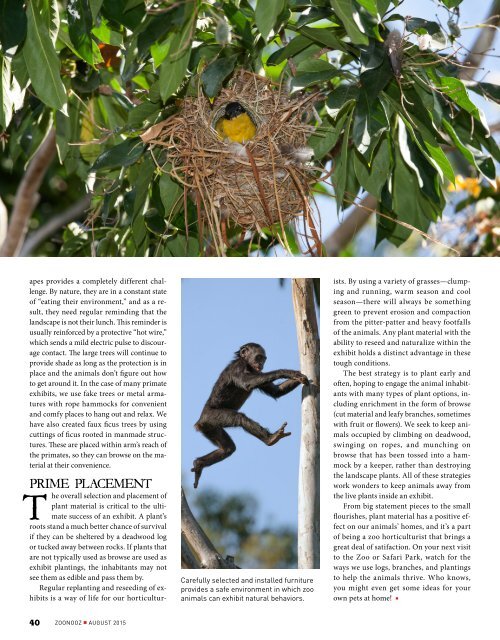You also want an ePaper? Increase the reach of your titles
YUMPU automatically turns print PDFs into web optimized ePapers that Google loves.
apes provides a completely different challenge.<br />
By nature, they are in a constant state<br />
of “eating their environment,” and as a result,<br />
they need regular reminding that the<br />
landscape is not their lunch. This reminder is<br />
usually reinforced by a protective “hot wire,”<br />
which sends a mild electric pulse to discourage<br />
contact. The large trees will continue to<br />
provide shade as long as the protection is in<br />
place and the animals don’t figure out how<br />
to get around it. In the case of many primate<br />
exhibits, we use fake trees or metal armatures<br />
with rope hammocks for convenient<br />
and comfy places to hang out and relax. We<br />
have also created faux ficus trees by using<br />
cuttings of ficus rooted in manmade structures.<br />
These are placed within arm’s reach of<br />
the primates, so they can browse on the material<br />
at their convenience.<br />
T<br />
Carefully selected and installed furniture<br />
provides a safe environment in which zoo<br />
animals can exhibit natural behaviors.<br />
PRIME PLACEMENT<br />
he overall selection and placement of<br />
plant material is critical to the ultimate<br />
success of an exhibit. A plant’s<br />
roots stand a much better chance of survival<br />
if they can be sheltered by a deadwood log<br />
or tucked away between rocks. If plants that<br />
are not typically used as browse are used as<br />
exhibit plantings, the inhabitants may not<br />
see them as edible and pass them by.<br />
Regular replanting and reseeding of exhibits<br />
is a way of life for our horticulturists.<br />
By using a variety of grasses —clumping<br />
and running, warm season and cool<br />
season—there will always be something<br />
green to prevent erosion and compaction<br />
from the pitter-patter and heavy footfalls<br />
of the animals. Any plant material with the<br />
ability to reseed and naturalize within the<br />
exhibit holds a distinct advantage in these<br />
tough conditions.<br />
The best strategy is to plant early and<br />
often, hoping to engage the animal inhabitants<br />
with many types of plant options, including<br />
enrichment in the form of browse<br />
(cut material and leafy branches, sometimes<br />
with fruit or flowers). We seek to keep animals<br />
occupied by climbing on deadwood,<br />
swinging on ropes, and munching on<br />
browse that has been tossed into a hammock<br />
by a keeper, rather than destroying<br />
the landscape plants. All of these strategies<br />
work wonders to keep animals away from<br />
the live plants inside an exhibit.<br />
From big statement pieces to the small<br />
flourishes, plant material has a positive effect<br />
on our animals’ homes, and it’s a part<br />
of being a zoo horticulturist that brings a<br />
great deal of satifaction. On your next visit<br />
to the Zoo or Safari Park, watch for the<br />
ways we use logs, branches, and plantings<br />
to help the animals thrive. Who knows,<br />
you might even get some ideas for your<br />
own pets at home! n<br />
40 <strong>ZOONOOZ</strong> n AUGUST <strong>2015</strong>



